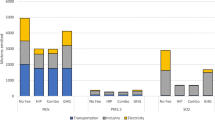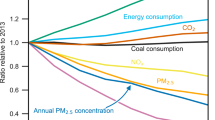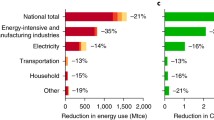Abstract
This study examines the monetary value of social costs—private costs and negative externalities—that could be avoided by energy conservation actions. A novel Air Resource Co-Benefits (ARCoB) model has been developed in this study to assess the comprehensive social benefits of greenhouse gas GHG mitigation policy. The rollback model is used to estimate changes in air pollutant concentrations attributed to the emission reductions. Change in ozone concentration is converted from non-methane hydrocarbons based on the maximum ozone increment reactivity. In addition to saved medical expenditure, years of potential life lost (YPLL) is estimated based on the exposure-response coefficients for mortality and is calculated with abridged life table. Two cases of energy efficiency improvement in different scales are analyzed to estimate the annual co-benefits of abatements of air pollutants and greenhouse gas in 2009: 1) the energy intensity reduction in the industrial sector and 2) energy saving at Taipei Taiwan City Hall. Results indicate the saved energy cost accounted for 66 % and 70 % in the first and second case, respectively, and was a major part of the total benefit from energy conservation. The saved air pollution fee was 7.8–8.5 times lower than the averted health cost of medical expenditure, which was US$10.34 million in the first case, in which there were also averted YPLL of 3,478 person-years or averted deaths of 311 persons per year.

Similar content being viewed by others
References
Anenberg SC et al (2012) Global Air Quality and Health Co-benefits of Mitigating Near-Term Climate Change through Methane and Black Carbon Emission Controls, Environ Health Persp 120(6):831–9
Amann M et al (2008) GAINS Asia: a tool to combat air pollution and climate change simultaneously: methodology. International Institute for Applied Systems Analysis (IIASA), Laxenburg, Austria
IAEA (International Atomic Energy Agency) (1999) Health and environmental impacts of electricity generation systems: procedures for comparative assessment. IAEA Technical reports series No. 394, Vienna, Austria
Bailey D, Knowlton K, Rotkin-Ellman M (2008) Boosting the benefits: improving air quality and health by reducing global warming pollution in California. Natural Resources Defense Council (NRDC), New York, US
Bickel P and Friedrich R (2005) ExternE externalities of energy, methodology 2005 update. Institut für Energiewirtschaft und Rationelle Energieanwendung — IER, Universität Stuttgart, Germany. European Commission Directorate, General XII, Luxemburg
BOE Taiwan (Bureau of Energy) (2010) Energy audit annual report for non-productive industries 2010. Taiwan Green Productivity Foundation, Taipei, Taiwan
Brajer V, Mead RW, Xiao F (2006) Valuing the health impacts of air pollution in Hong Kong. J Asian Econ 17(1):85–102
Cao J, Li W, Tan J, Song W, Xu X, Jiang C, Chen G, Chen R, Ma W, Chen B, Kan H (2009) Association of ambient air pollution with hospital outpatient and emergency room visits in Shanghai, China. Sci Total Environ 407:5531–5536
Cao J, Yang C, Li J, Chen R, Chen B, Gu D, Kan H (2011) Association between long-term exposure to outdoor air pollution and mortality in China: a cohort study. J Hazard Mater 186(2–3):1594–1600
Carter WPL (1994) Development of ozone reactivity scales for volatile organic compounds. J Air Waste Manage 44:881–899
Carter WPL (2011) SAPRC Atmospheric Chemical Mechanisms and VOC Reactivity Scales. http://www.engr.ucr.edu/~carter/SAPRC/
Chae Y (2010) Co-benefit analysis of an air quality management plan and greenhouse gas reduction strategies in the Seoul metropolitan area. Environ Sci Policy 13(3):205–216
Chae Y, Park J (2011) Quantifying costs and benefits of integrated environmental strategies of air quality management and greenhouse gas reduction in the Seoul Metropolitan Area. Energy Policy 39(9):5296–5308
Chang CC, Tsai SS, Ho SC, Yang CY (2005) Air pollution and hospital admissions for cardiovascular disease in Taipei, Taiwan. Environ Res 98:114–119
Cifuentes LA (2008) Training on air pollution health effects benefit analysis (APHEBA) model. Batter Air Quality (BAQ)
Clark County (2001) PM10 State Implementation Plan for Clark County: Appendix K: Rollback Methodology, Nevada, US. Available at http://www.clarkcountynv.gov/Depts/daqem/Pages/StateImplementationPlans.aspx
IPCC (Intergovernmental Panel on Climate Change) (2007) Climate Change 2007: Synthesis Report. Contribution of Working Groups I, II and III to the Fourth Assessment Report of the Intergovernmental Panel on Climate Change [Core Writing Team, Pachauri, R.K and Reisinger, A. (eds.)]. IPCC, Geneva, Switzerland, 104 pp
Crawford-Brown DJ, Barker T, Anger A, Dessens O (2012) Ozone and PM related health co-benefits of climate change policies in Mexico. Environ Sci Policy 17:33–40
De Nevers N, Morris JR (1975) Rollback modeling: basic and modified. J Air Pollut Cont Assoc 25:943–947
HEI (Health Effects Institute) (2004) Health effects of outdoor air pollution in developing countries of asia: a literature review, special report 15. Boston, US
Guttikunda S (2008) Air pollution & co-benefits analysis for Hyderabad, India. Simple Interactive Models for Better Air Quality (SIM-air), India
Hsiao DJ et al (2009) Research of Green Tax Reform. Chung-Hua Institution for Economic Research (CIER), Taipei
Hu T (2004) Policy implications of co-benefit on China: linking air pollution and GHGs, Policy Research Center for Environment & Economy (PRCEE). SEPA, China
IPCC (Intergovernmental Panel on Climate Change) (2001) Climate change 2001: impacts, adaptation & vulnerability (Third Assessment Report). Cambridge University Press, Cambridge
Li Y, Crawford-Brown DJ (2011) Assessing the co-benefits of greenhouse gas reduction: health benefits of particulate matter related inspection and maintenance programs in Bangkok, Thailand. Sci Total Environ 409:1774–1785
Liang WM, Wei HY, Kuo HW (2009) Association between daily mortality from respiratory and cardiovascular diseases and air pollution in Taiwan. Environ Res 109:51–58
Liu XL (2001) Assessment of costs on air pollution control in stationary sources. National Taipei University, Dissertation
Malla S (2009) CO2 emissions from electricity generation in seven Asia-Pacific and North American countries: a decomposition analysis. Energy Policy 37:1–9
Mandell S (2011) Carbon emission values in cost benefit analyses. Transport Policy 18:888–892
Mao X, Yang S, Liu Q, Tu J, Jaccard M (2012) Achieving CO2 emission reduction and the co-benefits of local air pollution abatement in the transportation sector of China. Environ Sci Policy 21:1–13
NREL (2005) Energy options and health benefit: Beijing case study. National Renewable Energy Laboratory, Report of IES Program, US
OECD (2000) Ancillary benefits and costs of greenhouse gas mitigation, OECD Publishing. doi: 10.1787/9789264188129-en
Rabl A (2003) Interpretation of air pollution mortality: number of deaths or years of life lost? J Air Waste Manage 53:41–50
Shakya SR, Kumar S, Shrestha RM (2012) Co-benefits of a carbon tax in Nepal. Mitig Adapt Strateg Glob Change 17:77–101
Smith KR, Haigler E (2008) Co-benefits of climate mitigation and health protection in energy systems: scoping methods. Annu Rev Public Health 29:11–25
Taiwan EPA (1997) Research on prevention and control strategies for ozone pollution, EPA-86-FA42-09-02, Taiwan
Taiwan BOE (Bureau of Energy) (2011a) Energy audit yearbook 2010. BOE, Ministry of Economic Affairs
Taiwan BOE (Bureau of Energy) (2011b) Energy Statistics Handbook 2010. BOE, Ministry of Economic Affairs, Taiwan
Taiwan DOH (Department of Health) (2010) Bulletin of statistics. Taipei, Taiwan
Taiwan MOI (Ministry of Interior) (2010) Department of Statistics. Taipei, Taiwan
Takeshita T (2012) Assessing the co-benefits of CO2 mitigation on air pollutants emissions from road vehicles. Applied Energy 97:225–237
The World Bank (2007) Cost of pollution in China: Economic Estimates of Physical Damages. Beijing
Thomas JM and Callan SJ (2010) Environmental economics: applications, policy and theory, South-Western, International Student Edition
Thurber MC, Chang J (2011) The policy tightrope in gas-producing countries: stimulating domestic demand without discouraging supply. Pacific Energy Summit, Jakarta, Indonesia
US EPA (1995) AP 42, Volume I, Fifth Edition. Accessed at http://www.epa.gov/ttnchie1/ap42/
US EPA (2004) The integrated environmental strategies handbook: a resource guide for air quality planning, Washington, DC, US, December, 2004
Wong TW, Lau TS, Yu TS, Neller A, Wong SL, Tam W, Pang SW (1999) Air pollution and hospital admissions for respiratory and cardiovascular diseases in Hong Kong. Occup Environ Med 56:679–683
Younger M et al (2008) The built environment, climate change, and health: opportunities for co-benefits. Am J Prev Med 35:517–526
Zhang D, Tang S, Lin B, Liu Z, Zhang X, Zhang D (2012) Co-benefit of polycrystalline large-scale photovoltaic power in China. Energy 41:436–442
Acknowledgement
The authors would like to thank the National Science Council of the Republic of China, Taiwan, for financially supporting this research under Contract No. NSC 94-2211-E-027-004 and NSC 96-2221-E-027-016. Ted Knoy is appreciated for his editorial assistance.
Author information
Authors and Affiliations
Corresponding author
Appendices
Appendix A
Emission factors of fossil fuels combustion in industrial boilers are based on AP-42 (US EPA 1995), due to lack of domestic data. EFs for electricity are estimated by the Taiwan Emission Data System (TEDS) version 7.0 published by the Taiwan-EPA and annual generated electricity.
Appendix B
National health insurance is compulsory for all citizens of Taiwan. The Bureau of National Health Insurance pays most medical costs to contracted health-care institutions. Medical expenditures are divided into outpatient, emergency visits, and admission/inpatient expenses. Outpatient cases in Taiwan are further divided into Chinese medicine and Western medicine. Table 8 lists the national medical expenditure in 2009.
Rights and permissions
About this article
Cite this article
Chen, YL., Shih, YH., Tseng, CH. et al. Economic and health benefits of the co-reduction of air pollutants and greenhouse gases. Mitig Adapt Strateg Glob Change 18, 1125–1139 (2013). https://doi.org/10.1007/s11027-012-9413-3
Received:
Accepted:
Published:
Issue Date:
DOI: https://doi.org/10.1007/s11027-012-9413-3




